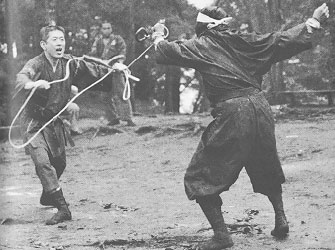Bujinkan – Soke
Soke Masaaki Hatsumi
宗家初見良昭
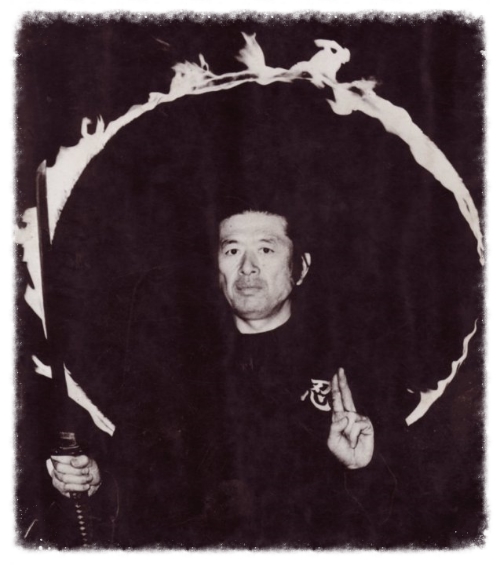
Osnivač i glavni učitelj organizacije za podučavanje ratničkih vještina, Bujinkan Dojo i nasljednik devet linija japanskih ratničkih vještina od svog učitelja Toshitsugua Takamatsua.
Soke Hatsumi Masaaki rođen je imenom Yoshiaki Hatsumi u gradu Noda, prefektura Chiba, sjever Japana, 2. prosinca 1931. Svoje ime Yoshiaki kasnije mijenja u Masaaki. Hatsumi je krenuo borilačkim putem još u svojoj ranoj mladosti. U dobi od 7 godina njegov otac ga je počeo podučavati Kendo, te je kasnije nastavio učiti Judo i Karate.
U srednjoj školi bio je gimnastičar, vođa nogometnog tima i boksač. Boks je trenirao tijekom zabrane treniranja borilačkih vještina u Japanu nakon Drugog svjetskog rata, prije nego što je prešao na starije oblike borilačkih vještina (Kobudō).
Naučio je i različite društvene plesove, što mu je, prema njegovim izjavama, pomoglo da razvije svoj Taijutsu pokreta tijela. Studirao je medicinsku osteopatiju i dramsku umjetnost na sveučilištu Meiji u Tokiju gdje je kasnije stekao titulu doktora. Tijekom svog studija, bio je zamoljen da podučava Američke vojnike u vojnoj bazi Yokata.
Izjava Soke-a Hatusmi-a Masaaki-a:
“Bio sam 4. dan u judu, pretpostavljam, stariji od 20 godina, otišao sam u američki vojni bazni kamp podučavati judo. Tu sam shvatio jednu stvarnost koja me iznenadila. Jednog dana dok sam im održavao trening, porazila me neočekivana waza (tehnika). Budući da su bili vojnici, poznavali su različite borbene waze, moguće da su kombinirali razne waze i koristili je cijelom svojom energijom. Kad sam se suočio s tim, shvatio sam da se od japanskog budoa kao sporta ne može preživjeti. Shvatio sam da ako nastavimo s ovom vrstom budoa, ne bismo ga mogli koristiti u pravoj borbi. Tada sam učinio sve što sam mogao. Proučavao sam svaki drevni budo i sve što se u Japanu zove budo, ne samo tijelom nego i mozgom.“
“Zapitao sam se koliko su zaista dobre borilačke vještine kada bi te velika i teška osoba mogla lako pobijediti?“
Hatsumi započinje tražiti pravu tradiciju borilačkih vještina.
Dok je proučavao kobudo (“drevno oružje”) s renomiranim instruktorom Hatsumi je saznao za učitelja po imenu Toshitsugu Takamatsu, zvanog “mongolski tigar” iz grada Kashiwabara koji se nalazi zapadno od regije Iga u Japanu. Kao posljednja nada da će pronaći učitelja koji bi mogao prenijeti bit žive ratničke tradicije, a ne samo neki rekreativni sport ili beživotnu umjetničku formu.

Hatsumi je otputovao preko otoka Honshu kako bi potražio učitelja kojeg je tražio cijeli život.
Vožnja vlakom trajala je više od pola dana od Hatsumijeve kuće do doma Takamatsua. Nakon prvog susreta s Takamatsuom koji je bio u 60-im godinama kada su se upoznali (1957. godine), Hatsumi je osjetilo kako iz njega izbija čudna aura. Tada je Hatsumi imao samo 26 godina. Pun samopouzdanja, Hatsumi je imao trening borbu sa svojim budućim učiteljem Takamtasuom i tu je prvi put iskusio bol tehnika istinskog majstora ratničkih vještina.
Hatsumi kaže:
“Bol njegove tehnike bila je drugačija od bilo koje boli koju sam ikad prije pretrpio. Osjećao sam samo hladnu, trenutnu bol, dok sam sa Senseiem bio izložen vrućoj, gorućoj boli. Kao da bi nešto eksplodiralo, da bi mi se isisala krv i odmah bi umro. Nisam primijenio samo jedan Gyaku nego četiri ili pet. Odmah sam znao da je to ono što tražim. Tražio sam da budem njegov učenik.“
U to vrijeme Takamatsu nije primao nijednog novog učenika, a ipak, vidjevši nešto posebno u ovom mladiću, pristao je podučavati ga. Za Takamatsua je sastanak više sličio na ponovno okupljanje nego na prvi sastanak.
U pjesmi Hatsumiju, Takamatsu je napisao:
“U danima Tenei ere bio je veliki gospodar Koppa. Bio je miran i miran poput proljetnog cvijeća. Ipak, bio je toliko hrabar da ga ni 10.000 neprijatelja nije moglo natjerati da pokaže strah. Mogao je čak i srušiti divlju životinju samo jednim udarcem.“
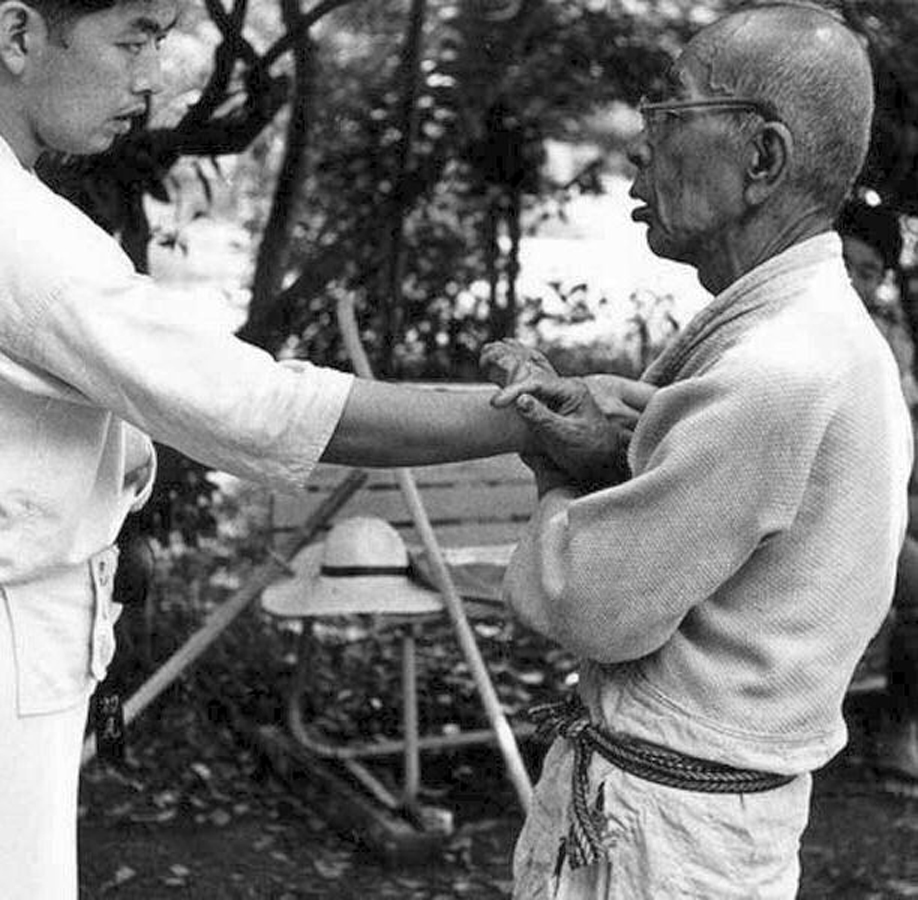
U 1950-im i 1960-im godinama, dr. Hatsumi je neprestano putovao po Japanu kako bi studirao kod Toshitsugua Takamatsua. Dr. Hatsumi je kasnije od svog učitelja naslijedio Menkyo Kaiden i položaj Sokea u sljedećim japanskim ratničkim školama (koje je Takamatsu naslijedio od svojih učitelja):
- soke Togakure ryu ninjutsua, koji je izvorno osnovao Daisuke Togakure
- soke Gyokko ryu koshijutsua, koji je izvorno osnovao Hakkunsai Tozawa
- soke Kukishin ryu happo hikenjutsu, izvorno osnovao Izumo Kanja Yoshiteru
- soke Shinden fudo ryu dakentaijutsu, izvorno osnovao Izumo Kanja Yoshiteru
- soke Gyokushin ryu ninjutsua, koji je izvorno osnovao Sasaki Gorozaemon
- soke Koto ryu koppojutsua, koji je izvorno osnovao Sandayu Momochi
- soke Gikan ryu koppojutsua, koji je izvorno osnovao Sonyu Hangan Gikanbo, gospodar Kawachija
- soke Takagi yoshin ryu jutaijutsu, izvorno osnovao Oriuemon Shigenobu Takagi
- soke Kumogakure ryu ninpo, izvorno osnovao Heinaizaemon Ienaga Iga, koji je usvojio ime Kumogakure Hoshi
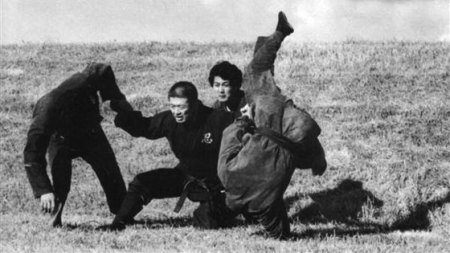
Više od petnaest godina Hatsumi je trenirao pod nadzorom Takamatsua, a 1972. godine, smrću svog učitelja, Hatsumi Sensei je postao nasljednik posljednje i najstarije ninja tradicije.
Od svog učitelja Takamatsu Sensei-a čuo sam sljedeće:
“Koliko god učio, to nikada nije dovoljno.”
Soke Hatsumi je autor više od desetak knjiga i 100+ videa o umjetnosti Ninjutsua. Bio je predstavljen u gotovo svim časopisima koji se odnose na ovu temu u Japanu, ali i u cijelom svijetu. Autor je nebrojenih članaka u časopisima i novinama o Ninjutsuu i produktivnom životu. Napisao je, režirao i glumio u 50 epizoda televizijske serije pod nazivom ‘Jiraya’ koja je bila broj jedan gledani dječji program u Japanu. On je sada ono što se naziva povjesničar borilačkih vještina za razne predstave i filmove, koji djeluje kao konzultant kako bi osigurao da ono što se prikazuje bude ispravno napravljeno na temelju istinite povijesti.
Hatsumi je bivši predsjednik udruženja književnika Japana. U Japanu je tražen kao govornik i televizijska osoba. On je vrsni glazbenik i pjevač koji svira gitaru i ukulele. Nekoliko godina svirao je u noćnim klubovima u havajskom bendu kao pjevač i glazbenik. Također je priznati slikar čije su slike izlagane na važnim izložbama diljem svijeta, slikar Nihonga
(日本 画, “japanske slike u stilu “). Temelje se na više od tisuću godina stare tradicije, izrađene u skladu s tradicionalnim japanskim umjetničkim konvencijama, tehnikama i materijalima.
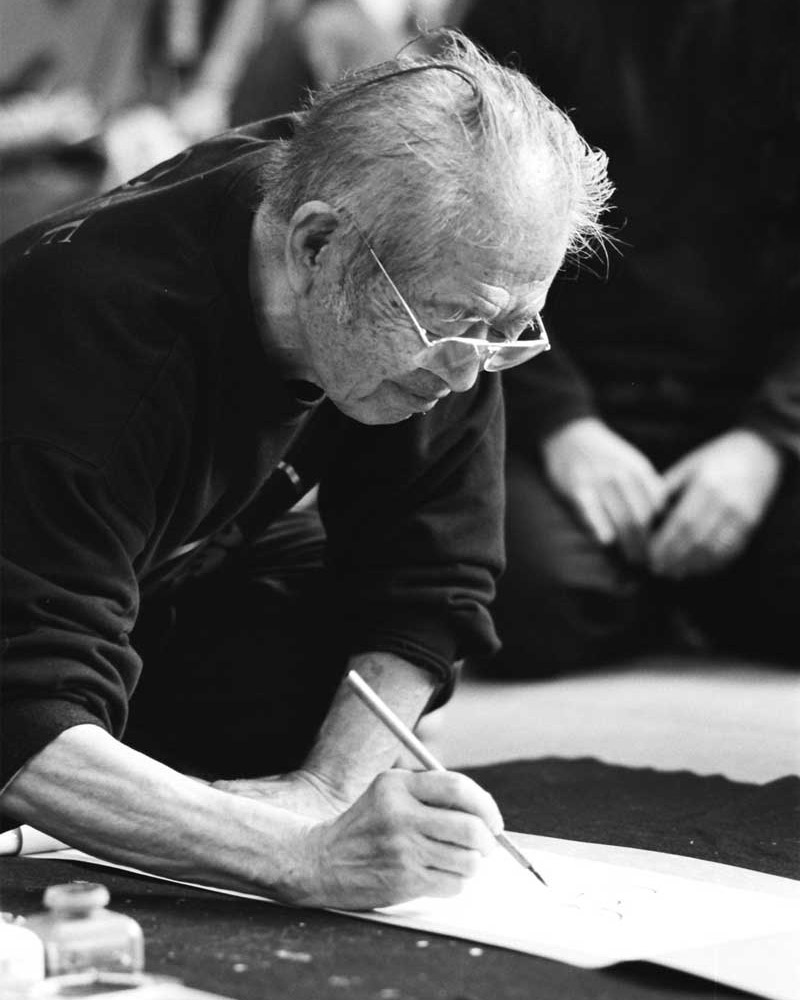
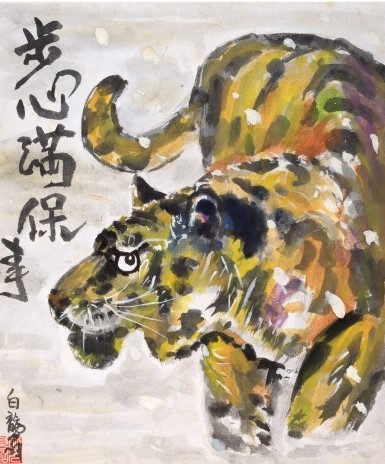
Dr. Hatsumi je održao niz seminara i obuka za FBI, CIA-u, Mossad i policiju u Britaniji, Francuskoj i Njemačkoj. Zidovi njegove kuće od 3 kata od cigle prikazuju razrađenu kolekciju potpisanih fotografija predsjednika i čelnika mnogih zemalja diljem svijeta, zajedno s nagradama, certifikatima i počasnim diplomama nekih od najelitnijih organizacija na svijetu,
-Pisma zahvalnosti Pentagona, ravnatelja Agencije za nacionalnu sigurnost i FBI akademije, SAD
-Pisma zahvalnosti i rođendanske čestitke američkih predsjednika Geralda Forda, Jimmyja Cartera, Ronalda Reagana, Georgea Busha i Billa Clintona
-Počasni član Texas Rangersa i Arizona Rangersa
(jedina osoba koja je počasni član oba)
-Apostolski blagoslov Njegove Svetosti Pape Ivana Pavla II., 2001.
-Svjetska kulturna velika nagrada: Odjel borilačkih vještina, Svjetska federacija za mir i kulturu, 2000.
-2001. Nagrada za životno djelo, USMA International Hall of Fame
-2003. – Nagrada za promicanje kulture, Japansko vijeće
-Nagrada za doprinos za društvo i kulturu, Japansko udruženje za promicanje kulture, 1999.
-Nakazawa Toshi, predsjednik Zen Nippon Todo Renmei (Svejapanska federacija mača), 1995. nazvao “Todo Hanshi” (majstorski učitelj puta mača)
-Predsjednik Međunarodnog odjela, Japanski klub književnih umjetnika, 1990.-1994.
-Instruktor godine časopisa Blackbelt, 1986.
– Medalje za križ i sunce, od kralja Juana Carlosa I (Španjolska)
– Profesor “Amatsu Ryoho no Budo” na Trinity Collegeu (SAD)
– Počasni doktorati na Manchester School of Osteopathy i Sveučilištu za tehnička istraživanja Euro
– Njemački nacionalni savez za povijesnu kulturu proglasio ga je “vitezom”.
-Nagrade španjolskog državnog tajnika za obavještajnu agenciju, iz sjedišta londonske metropolitanske policije
-Nagrada Odbora za obrazovanje i kulturu Noda City kao priznanje za doprinos Bujinkana međunarodnim odnosima između Noda Cityja i mnogih drugih zemalja širom svijeta
-Zahvalnice tajnika princa Charlesa, premijera Johna Majora, državnog tajnika za nacionalnu baštinu, državnog tajnika za okoliš, tajnika japanskog veleposlanika, gradonačelnika Londona i grada Belfasta (Sve UK)
-Pismo zahvalnosti premijera Južne Australije, Johna Bannona
-Pismo zahvalnosti predsjednika Mitteranda, Francuska
-Zahvalnica državnog tajnika Katalonije (Španjolska)
-Zahvalnice guvernera američkih država Teksasa, Georgije, Marylanda, Kalifornije, New Jerseyja i Tennesseeja te mnogih američkih senatora i kongresmena
-Počasni član zračne baze EVA 21, Kanarski otoci (Španjolska) i Kanarske japanske udruge za kulturnu razmjenu
-Počasni građanin država Teksasa i Novog Meksika te gradova Los Angeles, Atlanta, Gatlinburg, SAD; Dublin, Irska; Jordanska dolina, Izrael i mnoge druge …
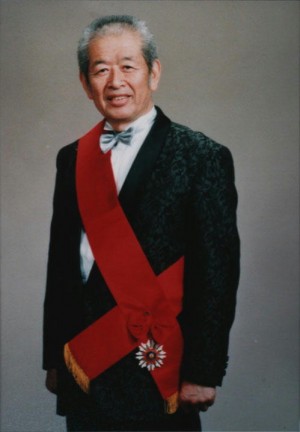
Hatsumi je došao u fokus zapadnog svijeta kada su se njegovi učenici počeli pojavljivati u časopisima o borilačkim vještinama kasnih 1970-ih. Tehnike demonstrirane u tim časopisima tada su se nazivale jednostavno tehnikama Ninja. Zapadnjaci željni znanja o ovim drevnim sustavima samoobrane potražili su svog učitelja i tako je Soke Hatsumi predstavljen na zapadu. Hatsumi je prvi put došao u Sjedinjene Države 1983. godine, a kasnije je putovao i predavao diljem Europe. U 1990-ima Hatsumi Sensei je počeo podučavati devet škola koje je savladao od Takamatsu Sensei-a pod zastavom Bujinkan Budo Taijutsua. Danas su ove studije postale ono što znamo kao Bujinkan Ninpo Taijutsu.
Bujinkan je Dojo Hatsumi Masaakija, trideset i četvrtog Sokea, voditelj je 900 godina stare Togakure škole ninpoa, borbene vještine nindže.
Gradeći na temeljima Togakure ninpoa, Hatsumi podučava svoje učenike tehnike preuzete iz ninjutsua i mnogih drugih drevnih ratničkih vještina koje prate svoje podrijetlo stotinama godina unazad u prošlosti Japana.
U svojoj 30 godini oženio se svojom lijepom suprugom Mariko, poznatom učiteljicom japanskog plesa i nositeljica 10. dana u Bujinkanu.
Kunoichi 女- Mariko Hatsumi, žena Soka Hatsumi-a preminula je 23.08.2020 godine.


Soke Hatsumi najpoznatiji je po tome što je “otvorio vrata” Ninjutsua cijelom svijetu, izvan Japana. Kao osnivač Bujinkan Dojo-a, Soke Hatsumi je aktivno putovao svijetom više od 20 godina dijeleći učenja Budo Ninpo Taijutsua koja mu je prenio njegov učitelj, Soke Toshitsugu Takamatsu.
